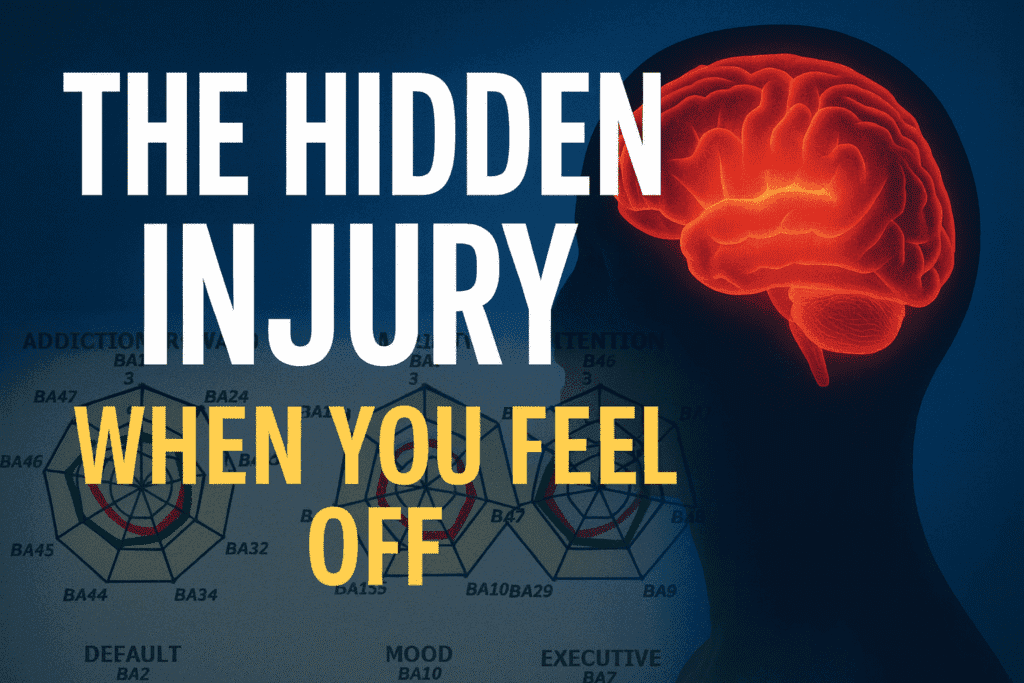qEEG Brain Mapping is changing how we understand brain injuries.
Most people believe you have to take a direct hit to the head to hurt your brain. You don’t.
Many of the patients we see at Genesis Brain Institute never blacked out, never cracked a helmet, and never even went to the emergency room. They walked away from a car accident, a hard tackle, or a sudden fall believing they were fine.
Yet weeks or even months later, something still feels off.
Their vision blurs under bright light.
Their focus slips in meetings.
Their emotions feel unpredictable.
And the harder they try to push through, the worse it gets.
Traditional scans like CT or MRI often come back normal, leaving people confused and searching for answers. These scans show structure, not function. They cannot reveal how the brain is communicating or where it may be struggling to keep up after an injury.
That is where qEEG Brain Mapping becomes invaluable.
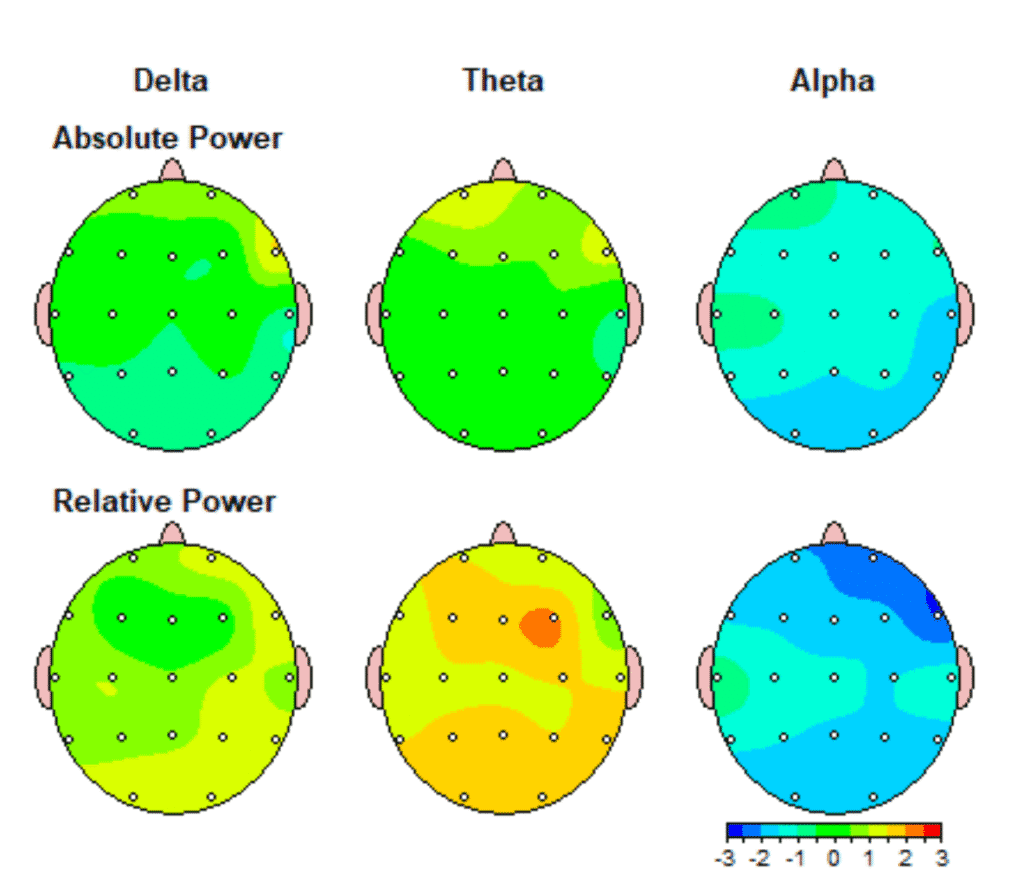
Unlike MRI, which looks at anatomy, qEEG measures how the brain is talking to itself. It can show when pathways responsible for attention, balance, mood, or sleep have been disrupted by the sudden movement of an impact, even one that only moved your neck and not your skull.
Whether you were hit from behind at a stoplight or took a hard fall on the field, your brain may still be fighting to find balance. The good news is that once you can see what is wrong, you can finally start to fix it.
When Traditional Scans Don’t Tell the Whole Story: Traumatic Brain Injury Treatment in Tampa
After the accident, she went home thinking she was fine. The impact had come from behind, and other than feeling sore and a little confused, she believed it would pass. But over the next few days, things began to change.
Her head felt heavy.
Her thoughts became slow.
Even simple conversations took effort.
By the end of the week, bright light made her dizzy and sound felt sharp. She started forgetting small things and felt strangely disconnected from herself.
Like many people who experience post-concussion symptoms without a direct hit to the head, she did not realize her brain had been affected. A rear-end collision can cause the brain to move rapidly inside the skull, stretching delicate neural connections that control vision, balance, and emotion.
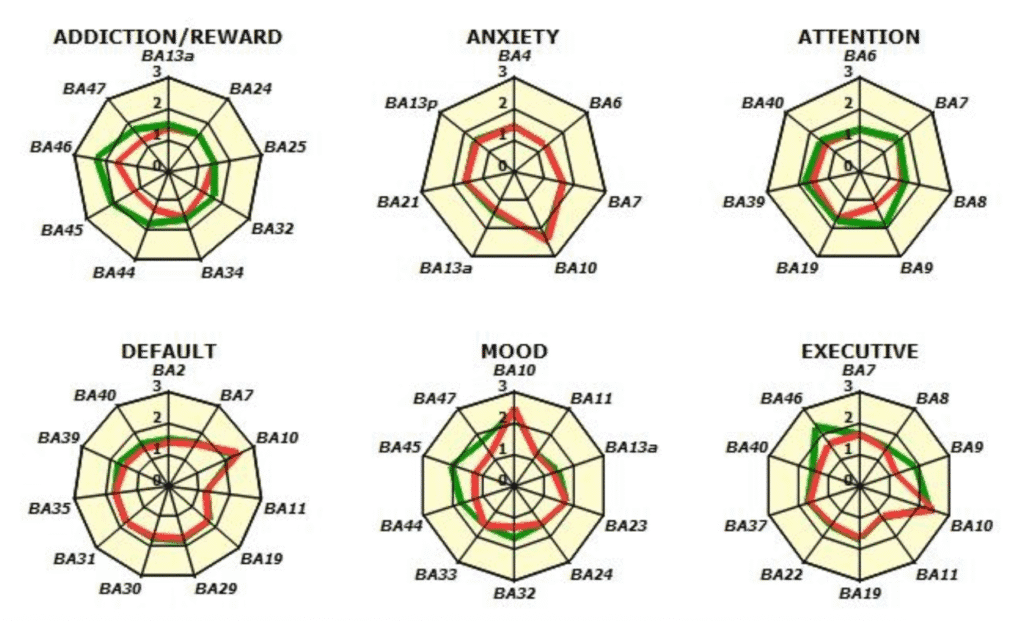
This is why so many people struggle long after an accident, even when their MRI looks normal. Traditional scans show structure, not function. They can identify a disc herniation or fracture, but they cannot reveal how the brain is communicating or where those pathways have been disrupted.
At Genesis Brain Institute, our approach to Traumatic Brain Injury Treatment in Tampa focuses on uncovering what traditional imaging cannot. Through qEEG Brain Mapping, we measure real-time electrical activity to see exactly how the brain is functioning. We look at how each region is communicating, which networks are overworking, and where regulation has been lost.
When combined with advanced Post Concussion Syndrome Testing that includes balance, vision, and cognitive testing, this creates a complete functional picture of the brain. It is how we identify the hidden effects of trauma that are often mistaken for stress, anxiety, or fatigue.
The result is clarity. For the first time, patients see the reason they feel off — and discover that what they are experiencing is not in their head. It is in their brain.
The Quant360 Functional Analysis: A New Standard for Brain Care in Tampa
At Genesis Brain Institute, we believe every symptom tells a story, and the only way to find real answers is to look at the brain from every angle. That is why we developed the Quant360 Functional Analysis a comprehensive approach that goes far beyond what traditional imaging can offer.
This process begins with qEEG Brain Mapping, which measures the brain’s electrical activity across different regions. It shows when certain areas are overactive, underactive, or out of sync with the rest of the brain. These patterns often explain why a person feels foggy, anxious, dizzy, or emotionally off balance after an accident, even when their MRI looks normal.
The Quant360 then layers in several additional tools that reveal how the brain and body are working together. A Brain Function Test evaluates reaction time, attention, memory, and processing speed. A Balance and Coordination Assessment tracks how the eyes, ears, and body communicate to maintain stability. Reflex and eye-tracking exams help identify disruptions in the vestibular system that can make someone feel disoriented, tired, or mentally slow.
Each result adds a piece to the puzzle. When combined, the findings create a detailed map of how the brain is functioning and where it needs support. This clarity allows our clinical team to design a personalized program that targets the exact areas affected — rather than guessing or relying on symptoms alone.
For many patients, the Quant360 Functional Analysis is the turning point. It is often the first time they have seen proof of what they have felt all along. The test provides not only data, but validation. And from there, healing becomes possible.
At GBI, our goal is not just to label a condition, but to uncover the root cause behind it. Because when you can measure how the brain is working, you can change the way it heals.
Inside the Quant360: What Each Test Reveals about the Brain
Each test within the Quant360 Functional Analysis tells a different part of the story. When combined, they create a clear map of how the brain and nervous system are functioning after trauma. This comprehensive approach helps our clinical team uncover the “why” behind symptoms that often go unexplained by traditional imaging.
The patient completed several key evaluations during her assessment at Genesis Brain Institute, including qEEG Brain Mapping, Cognitive Testing, Balance and Coordination Testing, Pupil Reflex Evaluation (PLR), and Video Oculomotor Testing (VOG). Together, these results revealed the hidden effects of the accident that could not be seen on MRI.
qEEG Brain Mapping Tampa: Seeing What MRIs Miss
The qEEG Brain Map is often the turning point for patients who feel off after an accident. While MRI scans show the structure of the brain, qEEG reveals how it is functioning. It records electrical activity across 19 regions of the brain to identify where communication has slowed, become overactive, or fallen out of sync.
In this patient’s case, the qEEG Brain Map showed slowed activity in areas responsible for focus, attention, and body awareness. These patterns are common after whiplash and post-concussion injuries, where rapid acceleration and deceleration stretch the brain’s communication networks. Dr. Kalambaheti explained that even when the head does not strike a surface, the brain can still experience internal strain that disrupts timing and coordination between regions.
These disruptions often explain why a person may feel foggy, anxious, or emotionally unpredictable after a minor accident. The qEEG findings confirmed that her brain was still in a reactive, protective state — a pattern we see frequently in patients with Post Concussion Syndrome or mild traumatic brain injury.
The data from her qEEG became the foundation for her care plan. It guided the next steps of treatment, showing exactly where her brain needed retraining through neurofeedback, biofeedback, and balance rehabilitation.
Cognitive Performance Test Tampa: Measuring How the Brain Thinks, Reacts, and Recovers
While qEEG Brain Mapping shows how the brain is communicating, the Cognitive Performance Test reveals how well those communication pathways are functioning in daily life. This assessment measures how efficiently the brain processes, remembers, and reacts to information, offering insight into attention, memory, reasoning, and processing speed.
During her Cognitive Assessment, the patient completed a series of computer-based tasks that evaluated memory, focus, planning, and reaction time. Her overall results were within the average range, but two key areas stood out. Both verbal reasoning and verbal short-term memory scored below average.
These findings matched exactly what she had been describing. She struggled to concentrate, experienced slower recall, and felt mentally drained after simple conversations or reading. Even though her MRI appeared normal, the testing revealed that her communication and language centers were under strain.
Dr. Kalambaheti explained that this pattern often appears when the brain is still compensating for injury. The systems responsible for thinking and communication remain intact, but they work harder than they should. Over time, this imbalance creates fatigue, slower processing, and frustration.
By identifying these patterns through objective testing, the team at Genesis Brain Institute could design a targeted plan to strengthen the affected networks. Treatments such as neurofeedback, cognitive training, and visual-motor exercises were chosen to rebuild timing and efficiency.
Together with the qEEG Brain Map, the Cognitive Performance Test Tampa provided measurable proof of how the patient’s brain was functioning in real life. It confirmed that her symptoms were not emotional or imagined. They were neurological, and they could be improved.
Balance and Coordination Testing Tampa: Understanding How the Brain Keeps You Steady
Balance is one of the most overlooked indicators of brain health. It is not just about standing upright. It is about how the eyes, inner ears, muscles, and brain communicate to keep the body centered in motion and at rest. Even a small disruption in this system can cause fatigue, dizziness, anxiety, or a constant sense of being off.
During her Balance and Coordination Testing, the patient completed a series of assessments designed to measure how her brain and body were working together. This included Video Oculomotor Testing (VOG) and Balance Platform Analysis, which track how the eyes move and how the body responds to subtle shifts in position.
When the VOG results were reviewed, the team noticed irregularities in her eye movement patterns. Her eyes were overshooting their targets, and the speed of correction was slower than expected. This type of finding is common after whiplash or post-concussion injuries, where the connection between the visual and vestibular systems becomes misaligned. Even though the injury came from behind, the force was enough to affect how her brain processed visual and spatial information.
These imbalances explain why she often felt unsteady in busy environments or when looking at screens. Her balance data showed that her brain was relying more heavily on vision than on sensory feedback from her body. This created extra work for the nervous system and contributed to her mental fatigue.
Through the Quant360 Functional Analysis, the clinicians at Genesis Brain Institute could clearly see that her sense of balance was not a mechanical issue but a neurological one. Once identified, the treatment team incorporated vestibular retraining, gaze stabilization, and neurofeedback sessions to help the brain restore timing and coordination.
The result was immediate understanding. For the first time, she could see why she felt unsteady, and she finally had a clear plan to regain balance and confidence.
Pupillometry Testing Tampa: Measuring the Brain’s Stress and Recovery Response
The eyes do much more than help you see. They are windows into how your brain and nervous system are functioning. Every time your pupils change size, they reflect how your brain is processing information, regulating stress, and maintaining alertness.
During her Pupillometry Testing, also called the Pupil Light Reflex (PLR) Assessment, a small camera recorded how her pupils reacted to changes in light. The goal was to measure how quickly and accurately the autonomic nervous system responded. In a healthy system, the pupils constrict and relax smoothly. When that response is delayed or uneven, it can reveal fatigue, poor regulation, or lingering effects of trauma.
Her results showed a sluggish constriction and a slower recovery time, which are common signs that the autonomic nervous system is under strain. This type of finding often appears after whiplash or concussion, when the brainstem and its regulatory centers have been disrupted. Dr. Kalambaheti explained that this imbalance can make people feel constantly “on edge,” even when nothing stressful is happening.
This test provided a missing piece of the puzzle. It showed that her body was still in a protective state, trying to guard against a threat that had already passed. That overactive stress response explained why she felt tense, why her sleep was inconsistent, and why her energy levels fluctuated throughout the day.
At Genesis Brain Institute, the Pupillometry Testing Tampa data helps guide therapy choices that calm the nervous system and rebuild regulation. Treatments such as biofeedback, neurofeedback, and breathing protocols are often used to train the body to shift from a state of survival back to a state of recovery.
When the eyes begin to respond normally again, patients frequently report better focus, steadier emotions, and improved sleep. It is one of the clearest signs that the brain is healing.
Video Oculomotor Testing Tampa: Revealing How Eye Movements Reflect Brain Function
The eyes are deeply connected to the brain. Every movement, blink, and point of focus relies on precise communication between the visual, balance, and cognitive systems. When that connection is disrupted, the brain must work harder to keep up. The result can be fatigue, dizziness, headaches, and a constant feeling of visual strain.
During her Video Oculomotor Testing (VOG), high-resolution cameras recorded how her eyes moved while following specific targets. This test shows how well the brain controls eye movement, focus, and tracking speed. In a healthy brain, the eyes move smoothly and symmetrically. When there has been trauma, those movements can become uneven, delayed, or poorly coordinated.
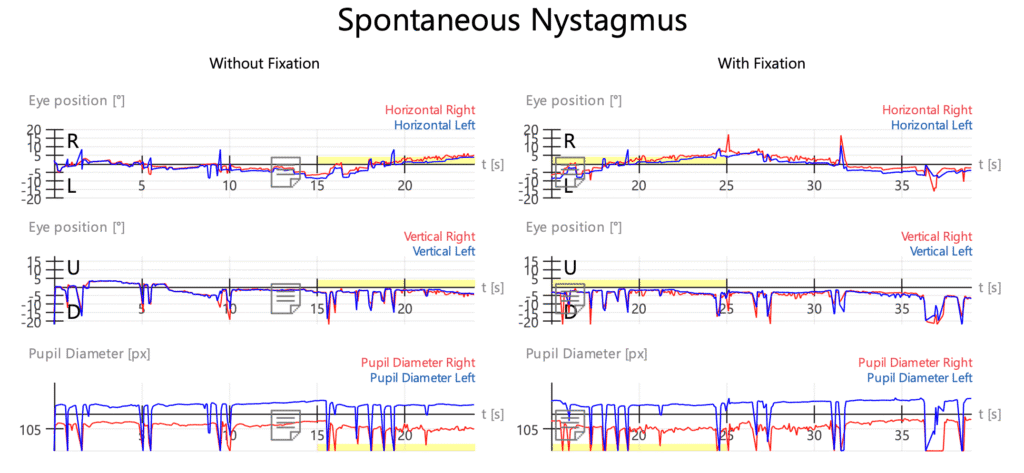
Her VOG results revealed small but meaningful irregularities. Her eyes often overshot their targets, and the timing of her rapid focus shifts was slower than expected. These findings are common after whiplash or mild traumatic brain injury, when the brainstem and cerebellum are under stress. Such irregularities can make the world appear unstable and can lead to dizziness, blurred vision, or difficulty concentrating.
Dr. Kalambaheti noted that these findings matched the symptoms she had been describing. When the eyes and brain fall out of sync, even simple tasks like reading or scrolling on a phone can feel overwhelming. The Video Oculomotor Test helped make these invisible issues visible.
By combining the Video Oculomotor Testing Tampa data with her qEEG Brain Map and Balance Assessment, the team at Genesis Brain Institute could see how multiple systems were affected by one event. This allowed them to design a plan that restored visual and balance coordination through visual-motor training, vestibular therapy, and neurofeedback.
For the patient, understanding that her vision problems were caused by disrupted brain function was both validating and hopeful. It showed that her symptoms were real, measurable, and treatable.
MRI Findings and Functional Correlation: When Back Pain Reveals a Hidden Brain Injury
After the accident, her main concern was the pain in her back. The MRI confirmed multiple disc herniations in her spine, which explained the soreness and stiffness in her neck and shoulders. Like many people who are hit from behind, she believed the problem was limited to her back. It seemed logical that the discomfort and fatigue were simply the result of the physical impact.
What she did not realize is that when the body absorbs that kind of force, the brain does too. Even without a direct hit to the head, the sudden movement from being rear-ended can cause the brain to shift inside the skull. That movement stretches and strains the delicate communication pathways that control focus, balance, and coordination. The result is a functional brain injury that traditional imaging cannot detect.
In her case, the MRI told only part of the story. It showed what was happening structurally in her spine, but the qEEG Brain Map, Balance Testing, VOG, and Cognitive Assessment revealed how her brain was responding. The data showed disrupted communication between regions responsible for attention, eye tracking, and emotional regulation. These findings explained why she continued to feel foggy, anxious, and mentally drained long after the physical pain began to fade.
Dr. Kalambaheti often reminds patients that the body and brain do not heal separately. Pain in the body can be a signal from the brain that deeper systems are still in distress. When the nervous system remains dysregulated, recovery slows and symptoms persist.
At Genesis Brain Institute, we see this pattern often in patients who have been hit from behind. The spine absorbs the immediate force, but the brain absorbs the lasting effects. That is why true recovery requires both structural and functional evaluation. A complete Traumatic Brain Injury Evaluation in Tampa using the Quant360 Functional Analysis provides that deeper insight.
For this patient, the results brought understanding and hope. Her back pain had a physical cause, but the other tests revealed the missing piece. The accident had affected her brain, and by identifying those changes, real healing could finally begin.
Restoring the Brain through Neuroplasticity and Non Medication Brain Therapy in Tampa
Once the Quant360 results were reviewed, the focus shifted from discovery to restoration. The brain has an extraordinary ability to heal itself through neuroplasticity, which is its natural process of rewiring and rebuilding connections. At Genesis Brain Institute, every therapy is designed to activate this ability and help the brain return to balance.
The patient’s program included several core therapies that worked together to retrain communication between the brain, body, and nervous system. Each modality played a different but complementary role in helping her feel clear, calm, and steady again.
Neurofeedback Therapy Tampa
Neurofeedback teaches the brain how to regulate its own activity. During a session, small sensors are placed on the scalp to measure electrical patterns in real time. The patient watches a screen or listens to sounds that respond instantly to their brain’s performance. When the brain produces healthy patterns, the system provides positive feedback, reinforcing what optimal regulation feels like.
Her qEEG Brain Map showed slowed activity in regions linked to focus and overactivity in stress-related areas. Through neurofeedback training, she learned to restore balance between these networks. Over time, her concentration improved, mental fog lifted, and she began to feel a renewed sense of control over her mood and energy.
Neurofeedback sessions are gentle, comfortable, and engaging. They do not involve medication or electrical stimulation. They simply teach the brain to find the rhythm it was always meant to have.
Biofeedback Therapy Tampa
Biofeedback focuses on the body’s response to stress and helps train the autonomic nervous system to stay calm under pressure. During sessions, sensors measure heart rate, breathing, and muscle tension while the patient practices specific relaxation and breathing techniques. The goal is to teach the body how to move out of a state of “fight or flight” and into a state of recovery.
Her Pupillometry results showed that her body was remaining in a guarded state even when she was at rest. This meant her nervous system was not fully shutting down the alarm response triggered by the accident. Through biofeedback, she learned to control her breathing and heart rate variability, which helped lower stress hormones and improve overall emotional balance.
As the weeks went on, she began to sleep more soundly, feel calmer during the day, and experience less physical tension. Biofeedback helped her body remember what safety feels like, which allowed her brain to continue healing.
Hyperbaric Oxygen Therapy Tampa
The brain needs oxygen to repair damaged cells and create new neural connections. Hyperbaric Oxygen Therapy (HBOT) enhances this process by delivering concentrated oxygen in a pressurized chamber, allowing it to reach deeper into the body and brain.
For patients recovering from traumatic or mild brain injuries, HBOT helps reduce inflammation, increase energy production, and promote tissue repair. In her case, it was one of the first therapies introduced to prepare the brain for other treatments. After each session, she described feeling more alert and focused, which indicated that the brain’s metabolism and blood flow were improving.
HBOT is non invasive and comfortable. Many patients use the quiet time in the chamber to rest, meditate, or simply breathe. It supports both the physical and neurological aspects of recovery, making it a vital part of the GBI protocol.
Vestibular and Balance Rehabilitation Tampa
The vestibular system controls how we move, stand, and stay oriented in space. When it becomes unbalanced, the brain receives confusing signals about position and movement, leading to dizziness, nausea, or a sense of instability.
Her Video Oculomotor Test and Balance Assessment revealed that her eyes and body were not communicating properly. Her brain was relying too heavily on vision to stay balanced, which explained her fatigue and unsteadiness.
Through Vestibular Rehabilitation, she completed guided exercises that trained her brain to reconnect its visual, auditory, and sensory inputs. These included gaze stabilization activities, balance platform work, and dynamic coordination drills. Over time, her dizziness decreased, her posture improved, and her confidence returned.
Restoring balance is more than physical. It helps the entire nervous system settle, allowing the brain to function with greater efficiency.
Cognitive and Visual Motor Training Tampa
Cognitive training helps rebuild the mental agility that is often lost after a brain injury. Using computer-based exercises and guided tasks, patients strengthen memory, processing speed, and problem-solving abilities.
Her Cognitive Performance Test had shown weaknesses in verbal reasoning and short-term memory. The team designed a program that challenged these exact areas, combining cognitive games, reaction-time drills, and real-world tasks that made the training feel purposeful.
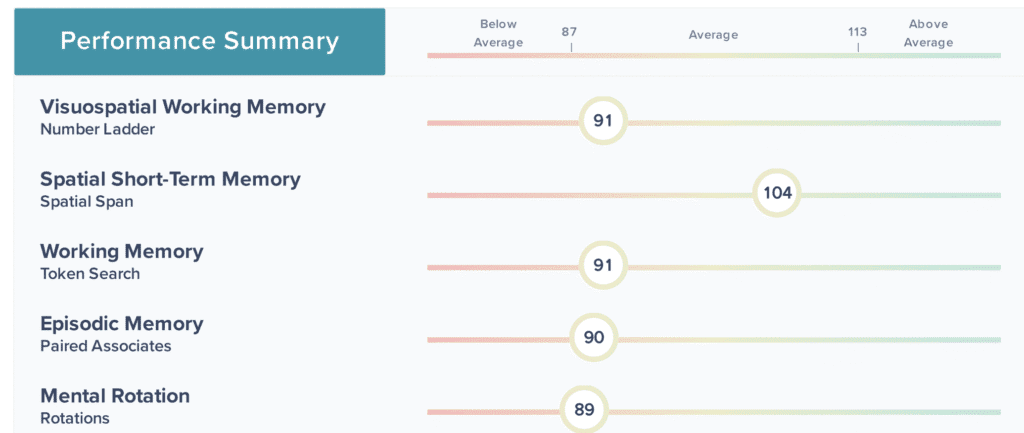
In addition, Visual Motor Training helped synchronize her eyes and hands, reinforcing the neural circuits involved in attention, coordination, and fine motor control. Each session provided visible progress, and she began noticing improvements in her focus, organization, and reading speed.
Cognitive and visual motor training are key parts of recovery because they remind the brain how to think clearly, move smoothly, and work efficiently again.
A System Designed for Healing, Not Just Management
Every therapy at Genesis Brain Institute is chosen to help the brain heal naturally. There are no medications to mask symptoms and no shortcuts that overlook the root cause. Each step of the program is informed by data from the Quant360 Functional Analysis, ensuring that every treatment supports the areas that need the most help.
For this patient, progress came from restoring balance between systems rather than treating each symptom separately. The combination of Neurofeedback, Biofeedback, HBOT, Vestibular Training, and Cognitive Rehabilitation allowed her brain to rebuild its communication pathways and rediscover its natural rhythm.
Today, she feels clearer, steadier, and more confident in her daily life. Her story is proof that healing is possible when you understand how the brain truly works.
The Neuroscience of Hope and Recovery With qEEG Brain Mapping
Healing the brain begins with understanding it. For this patient, that understanding changed everything. What started as back pain after a rear-end collision became a journey of discovery that revealed how deeply the brain and body are connected.
The tests from her Quant360 Functional Analysis showed that her symptoms were not random and not psychological. They were measurable signs of how her brain had been affected by the sudden force of impact. Once the cause was identified, healing could begin.
As her treatment progressed, her headaches faded. Her focus returned. Her emotions stabilized. The world around her stopped feeling overwhelming. Each session built upon the last, helping her nervous system regain balance and confidence.
Dr. Kalambaheti often explains that true recovery is not about masking pain; it is about restoring connection.
When the brain communicates clearly with the body, everything begins to work the way it was designed to.
At Genesis Brain Institute, this is what makes our approach different. We do not guess, we measure. We do not suppress, we restore. And most importantly, we do not treat people as a collection of symptoms, but as individuals whose brains are capable of remarkable change.
The science of neuroplasticity proves that your brain can heal. The question is not whether it can recover, but whether you will give it the chance to.
If you have been struggling with lingering symptoms after an accident, concussion, or period of high stress, there is hope. You do not need to live with brain fog, dizziness, or anxiety that will not go away.
Schedule your Quant360 Functional Analysis today at Genesis Brain Institute in Tampa.
Clarity begins with understanding your brain. Healing begins when you finally see what others have missed
Disclaimer: This content is for informational purposes only and does not constitute medical advice. Please consult with a licensed healthcare provider. Genesis Brain Institute is a Brain Treatment Center in Tampa offering non-pharmaceutical solutions that bring clarity, restore function, and offer real hope for those who feel lost, stuck, or simply want more from life.


